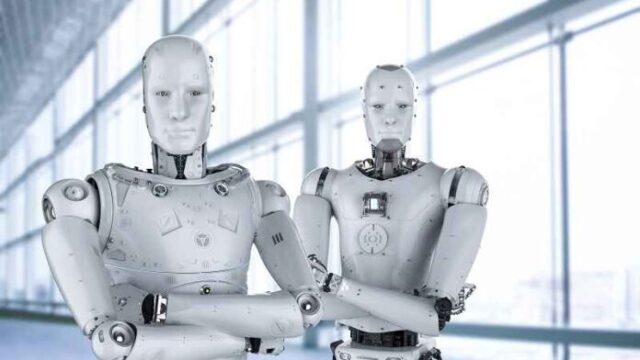WEF: Walking, Talking Humanoid Robots to Enter Society Within 4-5 Years

According to a discussion on technology regulations at the World Economic Forum (WEF), humanoid robots will walk and talk among us within four or five years.
The joint WEF annual meetings of the Global Future Councils and Cybersecurity concluded on October 16 with discussions on topics ranging from neurotechnology to food liberation and technology regulation, Sociable reports .
During the panel titled “Regulation: Friend or Foe?”, Jack Hidary, CEO of SandboxAQ, said that humanoid robots will enter society by 2030.
“The introduction of humanoid, walking, talking robots into our society will be a far bigger shock than any ChatGPT […] That’s only four to five years away.” – Jack Hidary, WEF Annual Meetings of the Global Future Councils and Cybersecurity, October 2025
” This will be a huge shock to the system as we introduce them [humanoid robots] into society. That’s only four or five years away .” – Jack Hidary, WEF Annual Meetings of the Global Future Councils and Cybersecurity, October 2025
“ Right now, as far as I know, we are all humans in this room, but in four or five years, when we have a WEF Global Leadership Futures Council in the UAE in this same room, there will be humanoid robots in this room ,” Hidary said.
“ They will be robots; they will be sitting in a chair; they will be taking notes or doing other things, and we will have to grapple with this as governments, as regulators, and as companies ,” he added.
One of the positive aspects of humanoid robots in society, according to Hidary, is that they will care for the elderly in their own homes, so they don’t have to go to nursing homes.
” As people age, they don’t need to go to a nursing home or other institutions, but can stay at home and be cared for by a robot. I think we all see this as something very positive .”
While robots caring for the elderly can be seen as a positive thing, especially for those without family members, it does take away the human connection that people may long for.
Let’s hope it doesn’t turn into a dystopian science fiction scenario like the Netflix series “Cassandra,” where the robot caregiver Cassandra suffers from some pretty horrific separation anxiety, leading to some rather dire consequences.
Dystopian or not, Hidary said that “ the introduction of humanoid, walking, talking robots into our society will be a much bigger shock than any ChatGPTs we are dealing with now.
” This will be a huge shock to the system as we introduce them into society. That’s only four or five years away .”
When asked which country is best equipped to manage and integrate robots into society, Hidary advocated for Japan.
“I predict that Japan will be one of the societies that makes the best use of robots […] Because they have an aging society […] They see robots as part of the solution, not as a threat,” said Jack Hidary.
Hidary praised Japan for preparing for the arrival of robots over the past 40 years while “ implementing regulations that ensure robots are safe .”
The SandboxAQ CEO’s words echo those of Larry Fink, interim co-chair of the WEF and CEO of BlackRock, speaking at the WEF’s 2024 Special Meeting on Global Collaboration, Growth, and Energy Development.
There Fink argued that developed countries with shrinking populations would be better prepared to deal with the social problems that arise from “ replacing people with machines .”
“I would argue that among developed countries, the big winners will be those with shrinking populations […] These countries will rapidly develop robotics, AI, and technology […] The social problems that come with replacing humans with machines will be much less severe in countries with shrinking populations.” – Larry Fink, WEF Special Meeting on Global Collaboration, Growth, and Energy Development, April 2024
“
We always thought that shrinking populations were a cause of negative growth, but in my conversations with the leaders of these large, developed countries that have xenophobic immigration policies, that don’t let anyone in and have shrinking populations, these countries are going to rapidly develop robotics, AI, and technology ,” Fink said in April 2024.
“ And if the promise, and it will happen, if the promise of all this transforms productivity, which most of us think it will, we will be able to raise the living standards of countries, the living standards of individuals , even with a shrinking population ,” he added.
Although Fink didn’t directly mention Japan, his words echo Hidary’s on robotics and the aging population.
Going back to what Hidary said about humanoid robots entering society in four or five years, what will it take to achieve that?
For some insights, we can look to the WEF’s 2025 Annual Meeting of the New Champions, also known as “Summer Davos.”
On June 24, 2025, Vanessa Evers, a professor at the University of Twente, explained that a digital twin of the entire world would be needed to achieve “true robot intelligence.”
“For real robotic intelligence, you need to build a model of the world, like a digital twin of the entire world.”
We could add superhuman capabilities, listening to a person’s heartbeat or observing their breathing to detect stress and pain. We could detect dominance, aggression, creative flow—there are all sorts of things you can detect in an automated way. – Vanessa Evers, WEF Annual Meeting of the New Champions, June 2025
Creating a digital twin of the entire world is an extremely complex undertaking that goes far beyond large language models like ChatGPT.
To achieve true robot intelligence, a large behavioral model would be needed to access and process massive amounts of real-world data, which is much more complicated than creating and feeding large language models.
ChatGPT has to choose from 26 characters. What’s the best next character? But what about the real world? Imagine that we only have sight and no hearing, touch, taste, and so on—just seeing things. If you were to take a still image and then predict what would happen next, it would be impossible to know that down to the pixel level.
According to Evers, “ in theory it would be possible to train a robot as a big language model, but then a big behavioral model – to take lots of real-world data and have it predict the next best action .
“ A large language model predicts what the next best sign is, but of course that’s super complicated in the real world .”
Returning to Hidary, he believes that through periodic meetings between stakeholders, regulations for humanoid robots should have the ability to update themselves.
He said: “ One way to ensure that all players in the field have an equal opportunity is for the government to convene the players, listen to them and maintain a process where the regulations themselves state that every six months or so there has to be a meeting with the key stakeholders, and we have to update it .”
“ Include that in the regulation itself to recognize that any robot law we enact today will be irrelevant in four or five years, and any law we enact four or five years from now will be irrelevant in 10 years .”
“ Let’s build the ability to update itself into the regulations themselves .”
The WEF’s special joint session, the Annual Meeting of the Global Future Councils and the Annual Meeting on Cybersecurity, brought together more than 500 experts from business, government, civil society, academia, and the media, along with 150 of the world’s leading cybersecurity leaders, from October 14 to 16 in Dubai, UAE.
